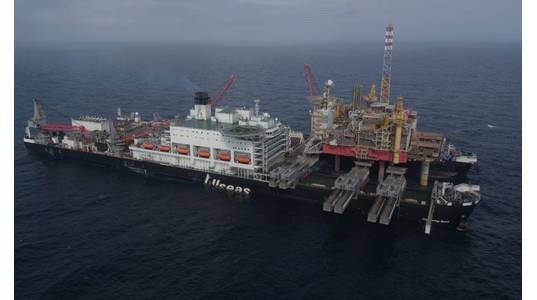
Madrid-based integrated offshore operator Repsol is leading a pack of foreign oil companies in Norway that are extracting largely tail-end production in exchange for paying a decommissioning tab or getting a second shot at an older oilfield.
Flush with the cash of consecutive money-making quarters — including €600 million in first quarter net profit — Repsol and partners are investing $950 million on the once-abandoned Yme field in the North Sea. It’s just part of the largesse a number of international oil companies, so to speak have been pumping into the North Sea rim.
Flanked by partners LOTOS of Poland (20%); 2018 Norwegian exploration and production (E&P) “start-up” OKEA (15%) and Kuwait’s KUFPEC, with 10%, Repsol is raising stranded Yme reserves with a bold “Yme New” project targeting the 65 million barrels of oil left in place by Equinor in 2001, when Canadian player Talisman bought the field and won accolades for its project concept before succumbing to design flaws and debt amid low oil prices. Repsol bought Talisman as the downturn began to bite in December 2014, and Yme’s value was again discussed.
The foreign players and OKEA are zealously optimistic about the new Yme. That zeal is, in fact, what they bring: OKEA “to bring undeveloped discoveries of less than 100 MM boe in reserves into production”; KUFPEC to pad the treasury at home and LOTOS, the E&P investment arm of the Polish industrial group to bring Norwegian oil to its refineries.
Housed in Stavanger, LOTOS E&P now wields 30 licenses in Norway, as many as Repsol, and produces about 17,000 barrels of oil equivalent per day, for three-quarters of its total production. LOTOS has invested in a mature Heimdal area project targeting 34 MM boe and in the Sleipner complex of reservoirs.
It’s at Yme where LOTOS’s 20% will help recover vales lost by Norwegian taxpayers when they partly paid to scrap the original Yme — a platform that had stood astride a seabed oil tank that’ll be used by Yme New.
Risk and revival
A video of the Yme platform showed the original platform swayed heavily before finally being evacuated by Talisman in 2012. Then in 2017, the new partners approved a plan for the field, and now “first oil” from the field is planned for the summer of 2020.
While OKEA partly debt-financed its interest in Yme, the likes of Repsol, KUFPEC and LOTOS were able to push through on Yme using their own reserves of cash. Their reward is expected to be 38,000 boepd of plateau production.
For the supply chain, too, the foreign operators have brought value. The Yme New Development is an obvious example, but the foreign operators have brought a willingness to take up interests in other maturing assets, including Sleipner and Heimdal (LOTOS) and Mykkel, Gyda and Visund (Repsol).
While Visund has only just yielded the nearby Telesto discovery for Repsol, KUFPEC seems to have signed up for a hard slog toward production funded by marginal tail-end production. Gyda (“low production”); Bream (license expired) and new development and redevelopment at Yme; Gina Krog; Sleipner; Utgard; Eirin and seismic at PL 813 and PL 850.
Yme New
Yme, in 93 meters of water, is an oilfield that first flowed for Equinor in 1996. It was shut down in 2001 when low oil prices made it unprofitable.
Yme New consists of a mobile jack-up production unit tied to the original oil tank from Talisman’s ill-fated (but award-winning) redevelopment. Oslo’s go-ahead for Yme New in March 2018 unleashed a raft of supplier awards, including platform removal and scrapping said to have cost over $100 million.
Sure, much of Yme’s decommissioning costs will be picked up by the original contractor’s insurance company and the field’s international partners. Lucky Norwegian taxpayers were thus spared the entire cost of decommissioning.
Capital infusions
The intervention of foreign cash at Yma will most of all benefit a starved North Sea supply chain chomping at the bit. As at the Gyda field — where Archer will plug and abandon 32 wells and decommission seabed structures for Repsol and KUFPEC until 2021 — Yme New comes with preliminary Yme decommissioning work.
So, in exchange for oil and gas, much of it tail-end or still under development, Norway’s foreign players are bearing some decommissioning costs while infusing energy and capital into redevelopment. They bring work for the supply chain with their project finance: beyond P&A, there’s Maersk Drilling — which will supply the production jack-up, Maersk Inspirer, for five years — Kvaerner (permanent caisson support); Aker Solutions (modifications); Atkins (FEED) and a comet tail of others.
Yet of the Yme partners, only Repsol picked up mature acreage in last year’s mature-areas licensing round. The Spaniards were awarded two.
It might be a sign that the rush to secure tail-end Norwegian production in exchange for decommissioning responsibility might be slowing.
Or it might not mean that.
But according to the UK Oil & Gas Authority, Britain has GBP 58 billion in decommissioning work left to do, far more than Norway’s 23 not-so-Yme-like cessation candidates. Decommissioning needs all the help it can get from international oil companies.
To lure them, you need tail-end production or, perhaps, a plan like Yme New.